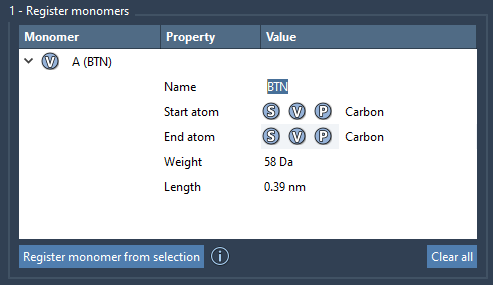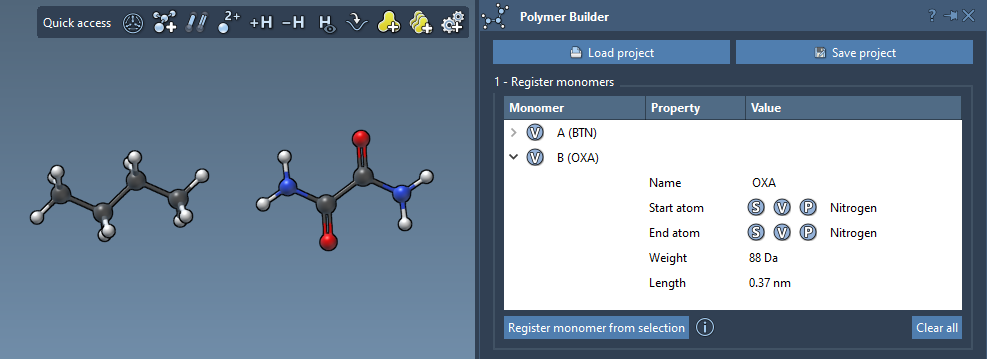One of the most common challenges in molecular modeling lies in **polymer customization**. You might have specific monomer units you want to connect or test, but lack a visual, structured, and flexible way to define them before building full polymer chains. SAMSON’s Polymer Builder addresses this by letting you register your own molecular fragments as monomers—ready to assemble into anything from biopolymers to materials for electronics or drug delivery systems.
This blog post focuses on Step 2: Register New Monomers from the Polymer Builder documentation and walks you through the process. Whether you’re simulating a custom sequence or modeling conjugated chains, this step is foundational.
Picking Your Fragment
Start by selecting your desired molecule or molecular fragment in the Document view or Viewport. This will be your monomer building block.
Once selected, click Register monomer from selection. The Polymer Builder will automatically detect the starting and ending atoms that define this monomer’s connection points.
Manual Override: You’re in Control
The auto-detection is handy, but you aren’t locked into it. If you want precise control, use keyboard shortcuts to manually assign start and end atoms:
- S: Select an atom in your structure to be used as the connection atom.
- P: Pick an atom from a list (by name or index).
- V: Highlight atoms to confirm your current selection.
This control is key when dealing with asymmetrical fragments or when directionality matters in your polymer (e.g., head-to-tail assembly).

The Monomer Table: Snapshot of Your Units
Once registered, monomers appear in a table with:
- A unique alphabetical label (A, B, C, …).
- Molecular weight in Daltons.
- Distance between start and end atoms (a clue to polymer geometry).
You can even edit the names in-place or expand to see more data. If you want to restructure your monomer library, right-click to remove items or press Clear all to reset.

Important Considerations
- If a monomer is based on a single residue or structural group, its name will reflect that automatically.
- If you edit the monomer’s structure afterward (e.g., add or remove atoms), it will be automatically deregistered. This avoids unintended usage of outdated structures.

Why it Matters
Registering monomers this way prevents bottlenecks later on when building sequences. Instead of having to redesign monomers on the fly, you’ll have a ready-made library. It also helps maintain consistency and reproducibility—two critical factors in polymer design workflows.
Whether you’re setting up synthetic polymers for coarse-grained simulations, chains for molecular brushes, or polymer-drug conjugates, investing time in monomer registration will save you from rebuilding and recalibrating down the line.
To dive deeper into building custom polymers with the Polymer Builder, visit the full documentation page here.
SAMSON and all SAMSON Extensions are free for non-commercial use. You can download SAMSON at https://www.samson-connect.net.





